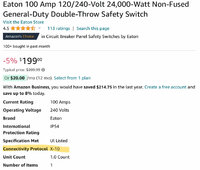bradley.r.zeller
New Member
Awesome, thanks for confirming my thinking!
Is this unwise? My thinking is that a critical loads panel will limit my self consumption and thus extend the ROI of this investment (e.g. if I place 50% of all my loads in the critical loads panel, the inverter could only ever offset 50% of my power consumption). In my head it makes more sense to have all loads downstream of the inverter, allow the inverter to provide as much as it can and utilize the grid blend feature to supplement the rest of my consumption from the grid (in the cases where I exceed the inverter). I think the only downside is the possibility of “manually” load shedding things in the case that the grid goes down… am I thinking about this right?
Can you explain this one a bit more? Not sure I follow.Of course, it does defeat the "visible blade" feature of the disconnect before inverter, because invisible internal fault would go around and back to grid. But go for it, same as any generator interlock in a panel.
This is probably ignorance on my part but I’ve attempted to add up a realistic (but unlikely) max load that I could pull from the panel at any given time and it’s just barely over the 12kw / 50a continuous output rating of this inverter. Because of the unlikeliness of this scenario (grid down while attempting to pull beyond 12kw) and because the inverter is rated for some solid surge output for 10-15m, I’m thinking I could get away w/o a critical loads panel. And if needed, manually load shed certain things if the situation arose.If inverter supports 200A pass-through (or 125A), when grid drops inverter is overloaded and shuts down, unless automatic load-shed. Interlocked breakers lets you manually shed big loads.
Is this unwise? My thinking is that a critical loads panel will limit my self consumption and thus extend the ROI of this investment (e.g. if I place 50% of all my loads in the critical loads panel, the inverter could only ever offset 50% of my power consumption). In my head it makes more sense to have all loads downstream of the inverter, allow the inverter to provide as much as it can and utilize the grid blend feature to supplement the rest of my consumption from the grid (in the cases where I exceed the inverter). I think the only downside is the possibility of “manually” load shedding things in the case that the grid goes down… am I thinking about this right?



